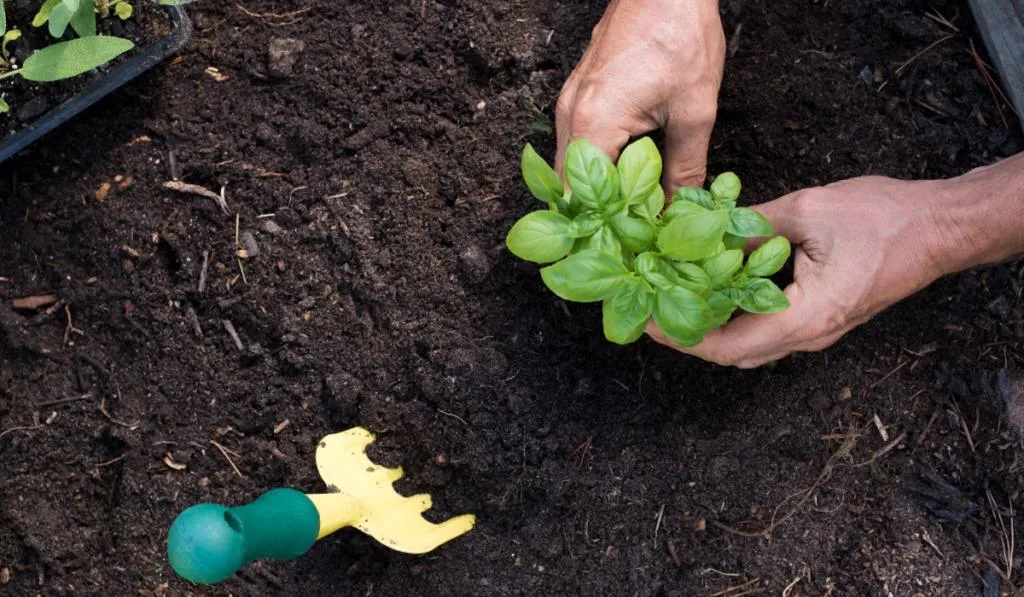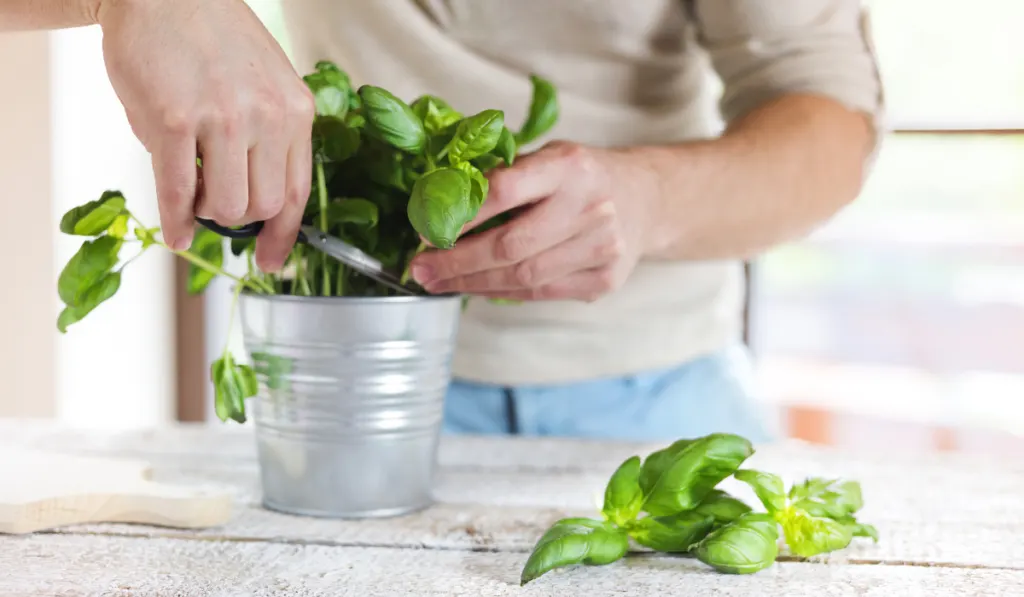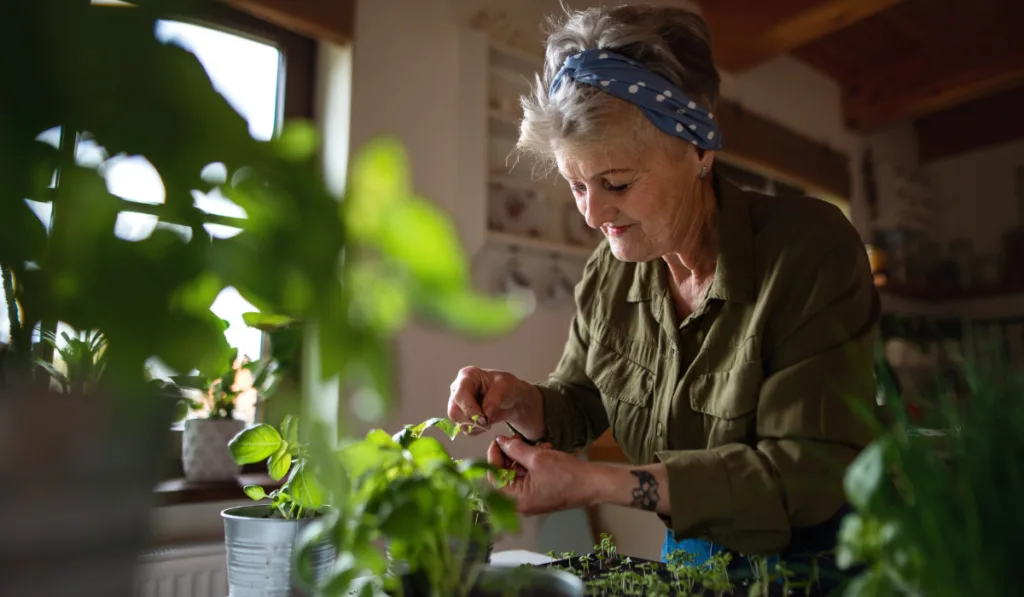Basil finds many applications in cooking. You can use it in your tomato sauce, in your salad, and as a spice. You can use basil whole, chopped, or in powder form. Apart from being something that makes food tastier, it also offers numerous health benefits.
But the thing is basil doesn’t appear in your kitchen out of nowhere. You either buy it from the store or you could grow it yourself. If you are worried about having no experience with growing basil, we’ve got your back. Here are 7 tips for growing basil you can tap from.

Table of Contents
Growing Basil From Seeds
When it comes to growing basil, there are 2 options: you can grow basil from seeds or cuttings. If you are growing from seeds, it is quite straightforward. You dig the soil about 6 inches deep, then you place the seeds it in and cover with a layer of soil (0.25 inch – 0.3 inch).
After about 5 – 10 days, the seedlings should appear. When the seedlings start sprouting a few leaves (3 – 4 leaves), thin them by about 12 inches or more. Basil seeds can be ready to harvest in as early as 1 month.
One of the best seasons to plant basil seeds is around spring when there is no more frost. Sunlight is one important factor for growing basil so ensure the plants get enough sunlight. The basil seed may not grow when the temperature is very low especially in winter. Even if it does grow, the seedling will not survive.
Best Soil for Basil
If you will plant basil, you need soil at neutral or slightly acidic pH (6 – 7.5). The soil should be well-drained, basils like wet soil but not too wet or soaked. If it is too wet, it might affect the plant.
You could add some manure to make the soil richer. But too much manure is not good. If you do too much to the soil, the basil might not be flavorful.
Also, ensure the soil is warm. This is why one of the best times to plant basil is spring. You can wait a few weeks after the last frost before using the soil.

Growing Basil Indoors
As hinted earlier, due to seasonal changes, it’s not always ‘safe’ to plant basil outside. But the good news is that you can plant them indoors. By growing your basil indoors, you can ensure that you have a constant supply of fresh basil on hand whenever you need it.
For indoor planting, the first thing you need is a pot. Almost anything that can hold soil and soil water can serve as your pot. Alternatively, you can buy starter pots.
So, you fill your pot with the soil. Add a few seeds to each pot. Sometimes the seeds may not germinate so add more than one seed.
After adding the seeds, water the soil but do not make it excessively moist. Cover your pot to keep the moisture in. By covering the pot, you will not have to water it until germination starts. Ensure that the pot receives at least 6 – 8 hours of sunlight daily.
When planted in pots, the soil dries up faster. So, if you are growing basil indoors, you have to water them frequently.

If you are planting your basil outdoors, ventilation may not be an issue. But indoors, ensure that the plant is exposed to sufficient air. Basil plants are susceptible to fungal attack in poorly ventilated spaces.
If you do not have basil seeds, you can also use basil cuttings. The cutting should have about 4 inches of the stem that has not grown leaves yet. Place the cutting in the soil and mold the soil around the base to hold it firmly. Then watch it grow.
Alternatively, you can plant the cutting in water. Place the cutting in a glass filled with water (non-chlorinated water). By using glass, you can easily monitor the growth of the root. Place this glass by the window to ensure it gets enough sunlight. You may change the water every other day.
The cutting will start growing roots within 2 weeks. When the root is as long as 2 inches or more, you can transfer it to a pot with soil.
Using Coffee Grounds for Basil
To coffee brewers, coffee grounds might be waste. But to you, a basil grower, coffee grounds can be very valuable. Coffee grounds contain a lot of nutrients that can help your basil grow.
Instead of getting a fertilizer for your plant, you can get coffee grounds instead. Coffee grounds contain nitrogen, potassium, phosphorus, magnesium, and iron. These minerals are all essential for plant growth.
Coffee grounds also draw worms to the soil. When worms are drawn to the soil, they penetrate the soil and improve soil aeration. This is another factor that aids plant growth.
Of course, that only helps for basil plants planted outdoors, but still it is an advantage!
Another advantage of using coffee grounds is that they can decontaminate the soil. Coffee grounds help remove heavy metals such as lead and cadmium from the soil. Lead is known to inhibit germination and plant growth but this can be mitigated by coffee grounds.

The First Harvest
You cannot start harvesting your basil immediately when it sprouts. You should wait until it is at least 6 – 8 inches tall. The best time to harvest your basil plant is very early in the morning. At this time, the leaves have more juice.
To harvest, you can pick the leaves or cut-back. No matter which method you decide to use, be gentle. If you scrape or bruise the leaves, you may lose the scent before you even get to use it.
Picking the leaves is quite straightforward. You pluck by breaking the stalk gently. Do not put too much pressure on the leaves so you don’t chafe them.
The cut-back method involves cutting a region of the stem 0.25 inch above a leaf node. The region of the stem you intend to cut must be at least 3 inches above the base. You have to leave some of the plants to ensure it regrows.
If you harvest frequently, the basil will grow faster. Even without frequent harvesting basil grows very fast. So you may have to prune them when they grow and get bushy.
Basils grow faster in the summer. So, if you increase the frequency of harvesting/pruning before or during summer, you will get a huge sprout in summer.

How Long Basil Lives
Basils do not live forever. But the good memories of the tasty meals you make from them might. Most species of basils are annual, within 12 months their lifecycle ends.
So, if you plant your basil after winter, you can expect that it would end its lifecycle by the end of summer or the beginning of fall. This is especially true for sweet basil but varieties like Greek basil, holy basil, and perennial basil live longer.
Keeping Basil Through Winter
Although basils do not usually live through winter, you can make yours live through winter. This can be achieved easily if you are growing the basil indoors.
The first thing you have to ensure is that the soil meets the requirements stated above. Apart from getting the right soil, you have to provide the right temperature. Normal room temperature (65 – 75 °F) would do but you can also use a heating mat to make the soil warmer.
Supply enough light to the plants, 6 – 8 hours of sunlight will do. But if that is not available, you can use fluorescent light. If you will use fluorescent light, you have to expose the plants to it for longer. Then ensure you water sufficiently not excessively.
Resources
- https://howtoculinaryherbgarden.com/grow-basil-from-seed-indoors/
- https://www.gardeningknowhow.com/edible/herbs/basil/propagating-basil.htm
- https://www.healthline.com/nutrition/uses-for-coffee-grounds#section1
- https://utopia.org/guide/growing-basil-harvest-plant-care/
- https://www.almanac.com/plant/basil
- https://www.aboutthegarden.com.au/basil-varieties-to-grow/
- https://growherbsgarden.com/is-basil-a-perennial/
- https://www.gardeningknowhow.com/edible/herbs/basil/basil-care-end-of-season.htm
- https://gardenerspath.com/plants/herbs/propagate-basil/
- https://savvygardening.com/growing-basil-from-cuttings/
- https://www.gardeningknowhow.com/edible/herbs/basil/growing-basil-seeds.htm
